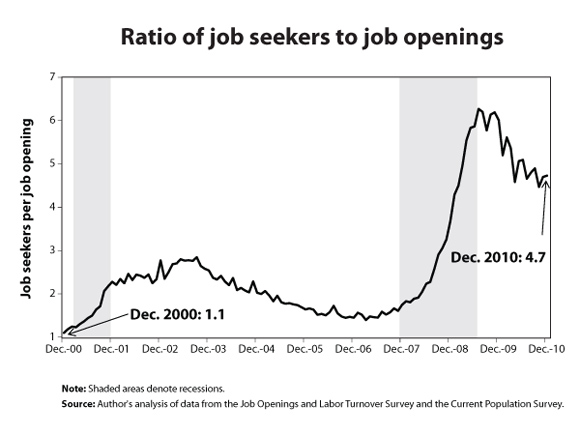This morning, the Bureau of Labor Statistics released a disappointing December report from the Job Openings and Labor Turnover Survey (JOLTS), showing that job openings decreased by 139,000 in December, while revisions to earlier data reveal that there were 46,000 fewer job openings in November than previously reported. In this piece, I assess the strength of today’s job openings numbers with respect to two benchmarks: (1) the number of unemployed workers, and (2) the number of job openings in the recovery following the recession of 2001.
The number of job openings compared to the number of unemployed workers
The total number of job openings in December was 3.1 million. The Current Population Survey shows that the total number of unemployed workers was 14.5 million. The ratio of unemployed workers to job openings was thus 4.7-to-1 in December, unchanged from the revised November ratio. Despite month-to-month fluctuations, the job seeker’s ratio has been generally improving since its peak of 6.3-to-1 in July 2009. However, at 4.7-to-1, the ratio is more than three times as high as its average ratio of 1.5-to-1 in 2007. The current 4.7-to-1 ratio means that for more than 3 out of 4 unemployed workers, there simply are no jobs.

The number of job openings now compared to the number of job openings in the last recovery
It should be noted that the release of this report marks the 10th anniversary of the JOLTS survey, which began in December 2000. Thus, the only other recession captured by these data is that of the early 2000s. After the early 2000s recession, job growth was very slow. The economy continued to shed jobs — 1.1 million of them – for 21 months after the recession officially ended. Yet this current recovery has generated far fewer job openings than even the extremely weak recovery of the early 2000s. In the first 18 months of recovery from the early 2000s recession (December 2001 to May 2003), the cumulative number of job openings in the economy was 62.6 million. In the first 18 months of the current recovery (July 2009 to December 2010), the cumulative number of job openings in the economy was 51.1 million, 18% lower.
In other words, the labor market has a significant shortfall of new job openings even when measured against the exceptionally weak recovery of the early 2000s. The millions of unemployed workers in this country continue to face a staggering scarcity of job openings. In light of this ongoing crisis in the labor market, the government should be doing much more on all three job creation fronts – fiscal policy, monetary policy, and exchange-rate policy.
For more information on the shortfall of job openings in the current recovery, see EPI’s paper Reasons for Skepticism About Structural Unemployment.
Research assistance by Kathryn Edwards and Andrew Green
